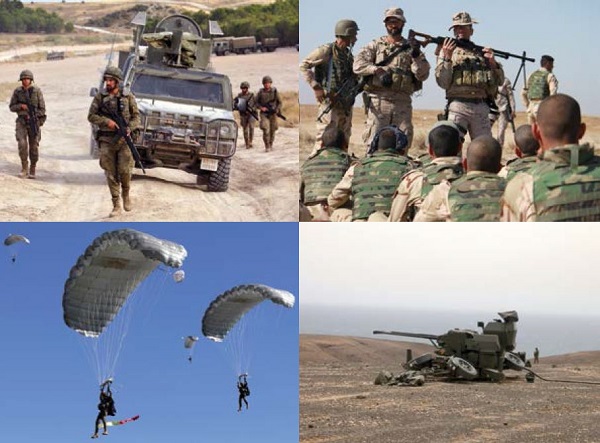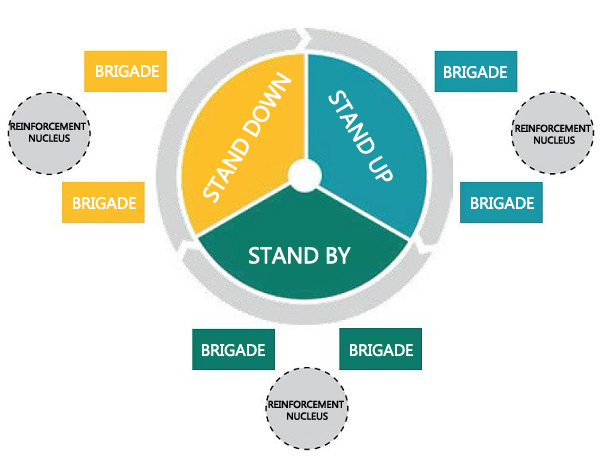Squaring the circle
miércoles 18 de marzo de 2020
Número: 96
Have you ever wondered why a certain unit is deployed at a specific time and to a specific location? Far from being a random or casual decision, the reason behind this designation is the result of a complex fitting together of pieces, which has to allow a response to all the commitments that the units of the Army have at both the internal and international level. Bearing in mind that these commitments include foreign operations - as part of NATO, the United Nations and the European Union -, participating in multinational structures, supporting civilian authorities and the permanent national contingency plans which require them to keep forces available for surveillance and presence tasks.
The availability plan
is updated to take into
account new situations.
In order to make everything fit, a conscientious study is necessary, of which the Availability Plan is the most tangible result, reflecting the succession of units and what level of training must be achieved in each of the phases that are set out. In this way, a periodical cycle is established which organises the availability of the Army’s units so that they are able to provide the capacities that the JEMAD (Chief of the Defence Staff) requires.

The implementation of the Very High Readiness Joint Task Force (VJTF) in 2016 introduced a new factor to be kept in mind when it comes to trying to fit all the pieces of the puzzle together and meant that the existing plan had to be revised. The result, which is now in place after months of study and a year of testing, is a new availability cycle which combines, in the best possible way, the availability of the units to meet the commitments made, their level of preparation and their rotation shifts in operational deployments. All the brigades and commands of the Army come into play in this rotation.
A three year cycle
The most significant change has been the move from a two year cycle with four biannual phases (preparation 1 and 2, immediate response and high readiness), to a three year cycle with three phases (general training or stand up; immediate response or stand by; and high readiness or stand down).
In the first phase, the units carry out general training from company level, moving up to battalion or inter-force tactical group, before completing, where appropriate, full brigade training (inter-force), in each case reaching the predetermined level of training, whether it be sufficient or desirable. In the immediate response phase, in which they are still in Spanish territory, those who participate in the mission will begin with the Operative Training Period (PAO in its Spanish acronym), the famous 4+2, until they achieve an optimum level of training. Then, in the high readiness phase, the deployment will take place.
Furthermore, following the adjustment which will come into action in June 2020, the brigades which are in the preparation phase will have no commitments and will not be deployed during this period. The new design also brings together international and national commitments in each of the phases. As a general rule, the handovers will take place in May and November (except in the case of Latvia and Turkey, which will be in January and July).
Brigades and reinforcements
In each phase of the cycle, activities will be carried out by two impact brigades and a reinforcement nucleus which is permanently linked to them. This reinforcement nucleus will be organised on the grounds of presence and immediate response forces. These three ‘pawns’ will be the base for the creation of the main yearly contingents. This generic cycle will not apply to combat units, combat support and combat logistical support, which are not organically part of impact brigades, permanent forces or initial entry forces, since due to their particular characteristics they have specific cycles of availability, including the combat logistics support units from the Operational Logistics Force.
The Army units will have to combine the production of troops for the area of operations with other commitments: that of maintaining permanent availability of a force package that the Chief of the Defence Staff requires to deal with two types of operations. The first type includes permanent presence and surveillance operations in the national territory and in maritime and air spaces under Spanish sovereignty and in the national interest, as well as cyber defence and collaboration and support to the civil authorities. The second type includes response operations which are triggered as a response to a crisis, both to act in the defence of Spain and beyond the national borders, working either under national command and using exclusively national means, including those of cooperative security, or in the multinational or bilateral framework with allies and partners.

This combination of units, headquarters and command elements and transferred trainers (from the Navy and the Air Force, as well as from the Army) must meet specific conditions of preparation and high availability, since they constitute the Joint Force Nuclei that are available to react immediately to any commitment or contingency.
The new availability cycle from the Army has organised the large units in three groups which are associated with the Joint Force Nuclei. In the Presence Forces group are the General Commands (of the Balearic Islands, Ceuta and Melilla), which provide units to the permanent surveillance, security and presence operations. However, they can also produce contingents for foreign operations or for national operations in response to a crisis.
In the Immediate Response and Initial Entrance Group is the 6th ‘Almogávares’ Brigade. This unit must always have a tactical battle group ready to be used wherever the Chief of the Defence Staff considers it to be necessary, particularly in regards to response operations in the national sphere.
The third group is the Impact Brigades, including the 1st, 2nd, 7th, 10th, 11th and 12th Brigades, which are fundamentally focused on response operations with partners and allies in security and defence organisations, although they contribute to both response operations at home and foreign deployments.
UNIDADES DEL EJÉRCITO
- Araba Álava |
- Albacete |
- Alicante |
- Almería |
- Asturias |
- Ávila |
- Badajoz |
- Barcelona |
- Burgos |
- Cáceres |
- Cádiz |
- Cantabria |
- Castellón |
- Ceuta |
- Ciudad Real |
- Córdoba |
- A Coruña |
- Cuenca |
- Girona |
- Granada |
- Guadalajara |
- Gipuzkoa |
- Huelva |
- Huesca |
- Islas Baleares |
- Jaén |
- León |
- Lleida |
- Lugo |
- Madrid |
- Málaga |
- Melilla |
- Murcia |
- Navarra |
- Ourense |
- Palencia |
- Las Palmas |
- Pontevedra |
- La Rioja |
- Salamanca |
- Segovia |
- Sevilla |
- Soria |
- Tarragona |
- Santa Cruz de Tenerife |
- Teruel |
- Toledo |
- Valencia |
- Valladolid |
- Bizkaia |
- Zamora |
- Zaragoza



